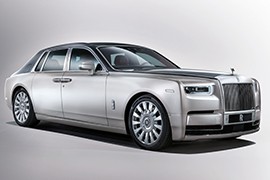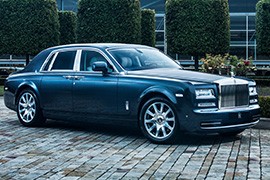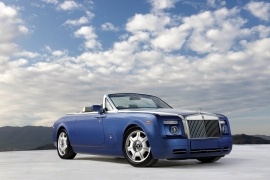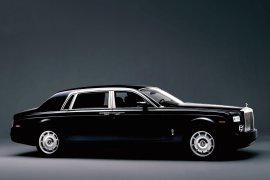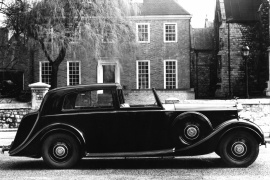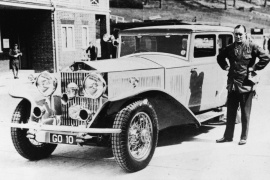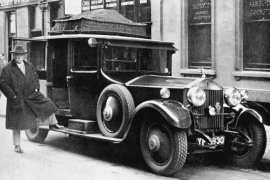ROLLS-ROYCE Phantom Models/Series Timeline, Specifications & Photos
First production year: 1925
Engines: Gasoline
The eighth generation of the majestic Rolls-Royce Phantom was unveiled in the Summer of 2017 and was built on top of a bespoke platform that was later shared with the Cullinan and the Ghost.
Ever since BMW had acquired the British luxury brand, its involvement was limited to the words of Sir Henry Royce, who spared no effort in building the best car in the world. He unveiled the first generation of the Phantom in 1925. Almost a century later, his legacy lived on, clearly embedded into the eighth generation of this nameplate.
With an exterior design that resembled the previous generation, the 2017 Phantom featured a flat front fascia with the "Parthenon" grille up front and squarish-looking laser headlights incorporating the daytime running lights. On the lower side, the bumper was neatly incorporated into the car's shape. It didn't look like an added bodywork element, as it happens with most other vehicles. From its profile, the cab-rearward design was emphasized by the long engine compartment. Also worth mentioning are the rear-hinged rear doors, also known as suicide doors. Rolls-Royce was the only luxury automaker that produced them. At the back, the sloped rear windscreen and the short deck ended the majestic limousine with an elegant design touch.
Rolls-Royce created an ultra-luxurious cabin to spoil its customers. Hand-made seats, Connely leather, and real wood trims were just part of the amenities that attracted Phantom's customers. In addition, for the rear-seated passengers, the automaker added a drinks cabinet with whiskey glasses, a decanter, champagne flutes, and a cooled box.
The car's platform was made from high-strength aluminum and featured pneumatic, adaptive suspension. Under Rolls-Royce's flagship hood was a BMW-developed twin-turbocharged 6.75-liter V12.
Opulent, grandiose and impressively powerful, 3 words to sum up the 2012 Phantom.
As you would expect, the ultra-luxurious Phantom’s cabin was fitted with the finest leather, wood trim and metal trim, plus sheepskin carpets and even hidden Rolls Royce badged umbrellas for rainy days.
Other distinctive features included an optional fiber-optic headliner designed to create the illusion of a starry night, cabin privacy curtains and a trunk-mounted wine cooler.
While the regular Phantom offered great interior room with impressive legroom and headroom for the rear passengers, Rolls Royce also offered the Extended Wheelbase version that added 10-inches rear-seat legroom.
Standard equipment included 21-inch alloy wheels, adjustable air suspension, power-closing rear coach doors, a power trunk lid, soft-close power front doors, a sunroof, automatic climate control, heated front and rear seats and even picnic tables for the rear passengers.
Also standard was a Bluetooth connectivity, a navigation system, a 15-speaker Lexicon audio system and voice control.
As if the extensive list of standard features was did not provide enough luxury, the Phantom could be heavily personalised by choosing the desired exterior color for an additional cost.
Standard safety features included antilock brakes, traction control and stability control, as well as side airbags and full-length side curtain airbags.
The 6.7-liter V12 engine produced 452 hp and took only 5.7 seconds in the sprint to 100 kph. There’s no reason to discuss the fuel consumption, as nobody would have bought a Phantom for fuel-economy reasons.
Rolls-Royce designed the Phantom Coupe to be driven by its owner, not by some hired chaffeur, and it succeeded.
Under BMW management, Rolls-Royce brand raised again, and the Spirit of Ecstasy shined proud on the Pantheon grille. The Coupe version of the Phantom was the most impressive personal luxury vehicle from its times. It was designed from scratch, built on an aluminum space-frame, and powered by a state-of-the-art engine.
Rolls-Royce is the most luxurious brand in the world, and it was the same in 2012 when the British brand introduced the Phantom Coupe. It was a new era for the famous carmaker, and with the technological help from the German carmaker, it succeeded to become great again. The big luxurious barge was designed to impress. Its massive size, flat and vertical front end, and low-roof stance were just a few elements that made the Phantom Coupe looks mean on the road. Its small headlights next to the massive silver grille didn't look out of place.
With its rear-hinged doors (suicide-type), the Phantom Coupe offered very easy access inside the luxurious cabin. It was a four-passenger vehicle, but it was mainly built for those at the front. Except for a few buttons, there was no plastic inside. A Rolls-Royce should have only leather, wood, and metallic interior elements. An infotainment display carried-over from the BMW 7-Series was installed on the dash panel, above the center stack.
The technology under the bodywork was another masterpiece, from the 6.75 V12 engine to the drivetrain and the suspension that could cancel the noise and offer a great comfort level.
With an imposing look and presence, the Rolls Royce Phantom was the choice of the buyers looking for exclusivity and opulence.
An ultra-premium luxury sedan, the Phantom was sold for a huge price compared to other luxurious sedans on the market, such as the BMW 7-Series or the Mercedes S-Class.
Easily recognisable as a Rolls Royce, BMW highly contributed to the Phantom’s engineering, while the model was equipped with the latest technologies available.
The Phantom was available in the base version or the EWB - the extended wheelbase model. Opting for the EWB was like adding another luxurious vehicle to your fleet, but value didn’t seem to be a point of interest for the buyers of such a model.
Most of the luxurious features came standard, such as 21-inch aluminum wheels, adjustable air suspension, bi-xenon headlights, LED running lights, soft-close power front doors, a sunroof, front and rear parking assist, heated seats, picnic tables, bluetooth, a navigation system, a premium 15-speaker sound system, voice controls and keyless go.
The interior was fitted with a leather headliner with wool and cashmere accents.
Besides the numerous standard leather and wood trim options, customers could choose their preferred color for the leather upholstery for an additional fee.
Other optionals included different alloys, a front and rear camera system, a rear center console, a drinks cabinet, the “Starlight Headliner”, rear curtains, 12-inch monitors in the back, a trunk-mounted wine cooler and others.
Due to the enormous dimensions, the Phantom was not the most pleasant car to drive around town, as handling was not top priority for such a luxurious and opulent sedan.
The ride quality however was flawless. Bumps, potholes - you name it - and the passengers could continue their nap as if it never happened.
With many great coupes launched under the Rolls Royce brand, it was time to add a new member to the Phantom family, the Coupe version.
While the coupe was not a sports car, it was still a sportier version with different dampers, a different roll bar and a more precise steering. The Rolls Royce CEO talked about the coupe saying it was more of a driver’s car.
The Coupe offered seating for 4 in great luxury, with great headroom and legroom for everyone.
The exterior design was inspired by the older coupes of the past, and the sloping roof was chosen from more than 3 variants proposed at the time, demonstrating the great attention given to every detail.
The coupe had a higher top speed, but it was still luxurious and comfortable.
The hinged doors added to the car’s attractive design and getting inside the cabin was a real pleasure. The controls were intuitively placed and were easy to reach while driving.
The attention to details was easily noticeable inside the cabin as well, with elegant touches added to the dashboard, such as an elegant dash clock.
Excepting for the saloon, the Coupe was one of the quietest cars available due to the extraordinary refinement levels.
Despite the heavy body for a Coupe, the luxurious vehicle reached 100 kph in around 5.6 seconds. The 6749 cc V12 engine developed 453 hp and was mated with a 6-speed manual transmission, the power being sent to the rear wheels.
Rolls-Royce unveiled the Phantom Drophead Coupe at the 2007 North American International Motor Show, introducing a new model in its lineup.
Rolls-Royce is unlike any other carmaker on Earth, and that's why it chose to name its convertibles differently. While the rest of the brands used the term "convertibles," the exclusive British manufacturer used the word "drophead." The new model took some inspiration from the 2004 100EX concept car, and it was an authentic open-top grand tourer, built not for speed but relaxed driving.
The car's design showed a massive front fascia, a long hood, plus short front and long rear overhangs. Even though the unusual-looking headlights were not everybody's cup of tea, they served the purpose of lighting the road and creating a unique appearance for this real estate on wheels. There were no pillars with the roof down between the A-pillars and the end of the car, although a retractable B-pillar was in place when the side rear windows were raised. At the back, the chromed surroundings of the taillights emphasized the car's width.
The interior was as luxurious as it could be. Rolls-Royce installed raised bucket seats at the front designed for comfort. Due to that, they were very thick, which led to smaller legroom for the rear passengers. But no detail was left aside, and the luxurious Connely leather upholstery was found on every interior panel, not only on the seats and the bench. It was assorted with the fine wood grain and the brushed aluminum from the dash and door cards. The three-spoke steering wheel resembled the Spirit of Ecstacy statue viewed from the front.
Under the hood, Rolls-Royce installed the same 6.75-liter BMW-sourced naturally aspirated powerplant mated to a six-speed automatic gearbox.
Drawing inspiration from the company’s heritage, the Rolls Royce Phantom unveiled in 2003 was the first model produced under BMW’s ownership.
In 2005, Rolls added to their range a longer Phantom named Phantom EWB - extended wheelbase. The increased wheelbase added 250mm to the rear cabin, offering the rear passengers more space and comfort, without compromising handling and agility.
To build the EWB, Rolls only needed to design a new aluminum roof and back door panels.
The design and the engineering team spent four years to develop the Phantom, and the result was a vehicle that was easily recognisable as a Rolls-Royce from any angle, retaining the traditional design cues.
The Rolls Royce factory located in Goodwood, West Sussex, used only 3 robots to produce the Phantom, while the final assembly was done by hand, including the body, the paint, the wood and the leather work, according to the customer’s individual specification.
Hand-assembled by the Rolls-Royce technicians, the heart of the new Phantom was a naturally aspirated 6.75-liter V12 engine. The unit was mated with a 6-speed automatic transmission and developed a massive 720 pound-feet of torque, with the luxurious Phantom reaching 100 kph in around 5.7 seconds.
Inside, simplicity defined the Phantom’s interior. The rarely used controls were kept out of sight and even the multimedia screen was hidden behind a revolving panel placed in the center of the dashboard. The most advanced technology available was combined with traditional hand-craftmanship, offering an unique and luxurious feel.
The rear cabin was equipped with picnic tables and 12-inch monitors linked to a six-DVD changer, besides allowing to view digital television.
Drawing inspiration from the company’s heritage, the Rolls Royce Phantom unveiled in 2003 was the first model produced under BMW’s ownership.
The design and the engineering team spent four years to develop the new Phantom, and the result was a vehicle that was easily recognisable as a Rolls-Royce from any angle.
Retaining the traditional design cues, the 2003 Phantom was built on a unique platform, with a body made mostly of aluminum.
The Rolls Royce factory located in Goodwood, West Sussex, used only 3 robots to produce the Phantom, while the final assembly was done by hand, including the body, the paint, the wood and the leather work, according to the customer’s individual specification.
Hand-assembled by the Rolls-Royce technicians, the heart of the new Phantom was a naturally aspirated 6.75-liter V12 engine. The unit was mated with a 6-speed automatic transmission and developed a massive 720 pound-feet of torque, with the luxurious Phantom reaching 100 kph in around 5.7 seconds.
Inside, simplicity defined the Phantom’s interior. The rarely used controls were kept out of sight and even the multimedia screen was hidden behind a revolving panel placed in the center of the dashboard. The most advanced technology available was combined with traditional hand-craftmanship, offering an unique and luxurious feel.
The rear cabin was equipped with picnic tables and 12-inch monitors linked to a six-DVD changer, besides allowing to view digital television.
The Rolls-Royce Phantom III Sedanca de Ville was the last luxury vehicle that Henry Royce worked on and the last V-12 Rolls-Royce built until the 1998 Silver Seraph.
Built with majestic bodywork, the Phantom III Sedanca de Ville featured an exquisite bodywork built by the renowned coachbuilder Mulliner between 1936 and 1939. It showed the wealth of its owner and the power of its builder.
The Sedanca name came from Sedan and Cabriolet since the vehicle featured a closed bodywork for the rear passengers and a removable top for the driver area. The same bodywork was named De Ville by other carmakers, but Mulliner had its idea on how to name its products. With a tall and flat front radiator and the famous statue on top of it, the vehicle showed nothing more than opulence. Behind the cabin, the carmaker installed the trunk with an up-hinged lid.
Mulliner built the unusually high greenhouse so the owner could wear a tall hat while comfortably seated in the back. Inside, the coachbuilder installed a comfortable leather-wrapped bench in the back, with side armrests. As an option, the carmaker offered a wooden minibar in front of the rear seats.
Under the hood, the 7.3-liter V-12 engine was an engineering masterpiece for those times. It featured hydraulic tappets and a twin-spark ignition system (two ignition coils and 24 spark plugs). But the system proved to be less reliable, and starting with 1938, the carmaker installed regular, adjustable tappets.
ROLLS-ROYCE Phantom III Sedanca de Ville by H.J. Mulliner 7.3 V12
Rolls-Royce introduced the Phantom II in 1929, and the carmaker didn't intend to make it with a short-wheelbase, but one year later, it reconsidered that option.
Rolls-Royce Phantom II proved to be a highly successful model, and the British car manufacturer managed to sell 1,680 chassis, from which 281 were with Continental, short-wheelbase versions. Their bodyworks were built by various coachbuilders from the U.K., and the Barker&Co was the one that put a sports one, with four doors. The Phantom II Continental was the last built under the personal supervision of Henry Royce before its death in 1933.
When Rolls-Royce built the new car, it made it on a new low-slung frame with the radiator set well back. This allowed the coachbuilders to make sleeker bodyworks, and Barker took advantage and created a bodywork with a raked windshield and a short rear end. At the front, the car featured two headlights mounted on the wheel-fenders. The Phantom II was the first Rolls-Royce to sports 11 degrees tilted louvers on the engine compartment's sides. Since the Continental was more of a driver's car, the coachbuilder installed rear-hinged front doors to ease-up the ingress and egress and front hinged-doors in the back.
Inside, the cabin received special treatment, according to customer's requests, but they usually went for wood and leather combination. The carmaker installed a speedometer in front of the driver post and the rest of the dials and gauges in the middle on the instrument panel. The carmaker placed the glove-box on the passenger side.
Rolls-Royce made a new engine for the Phantom II. It received a cross-flow cylinder head and counter-weights for the crankshaft. With a Barker bodywork, the car was timed with a maximum speed of 92.31 mph (148.55 kph) by an independent tester.
ROLLS-ROYCE Phantom II Continental Sports Saloon by Barker 7.7
The second generation of the Phantom appeared during the harsh time of the Great Depression that started in September 1929, but despite that, it was a successful model being produced until 1936 in almost 1,700 units.
It was the last brainchild of Sir Henry Royce, the head of his company’s design department, and was a big improvement over the first generation of the Phantom that was launched in 1925. Even if it didn’t match the sales of that model, it remained the last inline-six-powered Rolls-Royce that roared the roads of the world before WWII. Furthermore, it introduced several significant technical upgrades that transformed the vehicle into a reliable, comfortable, and quiet vehicle. These attributes made it a sought-after luxury car for the rich and wealthy from that era and the last Rolls-Royce to sell in over 1,000 units before the war turned the world upside down.
In those times, it was very usual for customers to order their cars from the factory as rolling chassis and get them equipped with custom-made bodyworks made by coachbuilders. Still, Rolls-Royce had some strict requirements, and only a handful of companies were allowed to finish the vehicles. Still, there were a few distinct elements that came with the vehicle, such as the tall, straight-up radiator with the Spirit of Ecstasy statue mounted on top of it. As a result, the Phantom II came fitted with a long engine compartment that featured louvers on the sides to help cool the powerplant.
From its profile, the Phantom II sported a tall greenhouse with an almost vertical windshield. The Landaulet versions featured a removable leather cover for the front compartment and a retractable roof for the rear-seated ones. Behind the vehicle, Rolls-Royce created a special rack for a removable trunk so customers could get it as a whole, so they didn’t have to load the car. Just the trunk and have it attached to the vehicle. Depending on the options, customers could fit the vehicle with spare wheels mounted on the sides of the engine bay or behind the cabin and the removable trunk. Thanks to the newly designed chassis, the car sat lower to the ground than the Phantom I.
Inside, the only mandatory items were the dashboard and the driving post. Rolls-Royce installed the main dials in the middle of the dash panel with a large speedometer that could be read even by the rear-seated passengers. The four-spoke wooden steering wheel sported the controls for the ignition timing in its middle. All vehicles were fitted with a right-hand driving post, and the gear-stick was mounted on the floor, on the right side of the cabin.
The car’s underpinnings were excellent for those times. It featured new, semi-elliptic leaf springs on both axles and a central lubrication system. Under the hood was an OHV push-rod engine with cross-flow that produced 120 PS (118 hp). It sent the power to the rear wheels via a four-speed manual transmission. Furthermore, the Phantom II was the first Rolls-Royce to have its gearbox directly attached to the engine.
Rolls-Royce introduced the Phantom II in 1929 as the last of the 40/50 hp models, and it offered it with a choice of two wheelbases and a variety of bodyworks.
Like most luxurious carmakers from that era, Rolls-Royce signed a contract with exclusive coachbuilders renown for their products. In 1929, Rolls Royce appointed Park Ward to provide the bodyworks for the Phantom II. Due to the Wall Street crash of 1929 and the following years of The Depression, only 1,693 were built, and 281 were Continentals.
The short wheelbase versions of the Phantom II were named Continental since they were built for high cruising speeds on continental roads. Park Ward made a low greenhouse for the luxurious four-door sedan. It sported the same upright radiator at the front and a pair of big headlights. A third light was added as an option above the bumper. Its long and curved wheel-arches continued on the side-steps. The rear door was narrower, but that was fine; the car was built for the driver, not the rear passengers.
Inside, the customers could hand-pick the materials used, but the most often seen combination was with leather and wood. Some owners chose ivory and silk for side curtains. The dials and gauges took center stage of the dash panel. There were two individual seats at the front, while in the back, the coachbuilder installed a bench for three. Unlike the limousine, long-wheelbase versions, the Park Ward Continental II featured a shorter greenhouse. Behind the cabin, the coachbuilder installed the trunk, which was accessible only from the.
Under the hood, a 7.7-liter inline-six engine provided 120 hp. Thanks to the high gearing for the final drive, the car could sustain a higher speed for longer distances. The early models featured non-synchronous gearboxes, while the later models received a synchromesh system from the second to fourth gear.
In 1925, Rolls-Royce replaced the successful Silver Ghost with the New Phantom, which was later known as the Phantom I since other vehicles that came from the British brand wore the same nameplate.
Replacing a highly appreciated luxury vehicle such as the Silver Ghost was not an easy job, and Rolls-Royce knew that it had to do something great to convince its picky customers that the change was worth it. In an era where those vehicles were among the most expensive in the world, its deep-pocket customers expected nothing but the best in terms of elegance, performance, reliability, and comfort. As a result, the British car manufacturer had to create an excellent platform and then cooperate with famous coachbuilders to complete the bodywork at customers’ requests, and that’s exactly what Rolls-Royce did.
Since the British automaker knew that it had many customers in the U.S., it also built the Phantom in Springfield, Massachusetts. While there were some differences between cars made in the UK and in the States, the quality was the same. Furthermore, the British car manufacturer bought the American coachbuilder Brewster & Co. in 1926 to ensure high bodywork quality. Vehicles built in Derby were completed by various coachbuilders, such as Park Ward, Barker, Mulliner, Zagato, and others.
Rolls-Royce had already gained a high reputation among car manufacturers for creating extraordinary vehicles and aimed to improve constantly. As a result, the Phantom, later known as the Phantom I, got a new inline-six engine with overhead valves instead of side-mounted ones. In addition, the twin spark plugs per cylinder system ensured that the engine could run smoother. That system was needed due to the big bore of the cylinders and the fact that the ignition was not that much evolved in those times. The 100 BHP (101 PS) powerplant had a 7.7-liter displacement.
The sturdy chassis was supported by a beam axle and double semi-elliptic leaf springs at the front and a live rear axle with leaf springs out back. Vehicles made in Springfield were fitted with a three-speed manual gearbox, while those coming from Derby relied on four-speed manuals. Stopping power was provided by drum brakes on both axles.
Regardless of their assembly plant, all vehicles came with the same upright, tall silver radiator grille, and its louvers could be opened and closed via a switch mounted on the dashboard. On top of it stood the proud Spirit of Ecstasy. The big round headlights supported on a horizontal bar could swing downwards via a lever mounted next to the driver’s seat. In front of the driver, the automaker installed a flat wooden dash panel that sported the speedometer, the tachometer, and several other gauges. U.S. versions even had a fuel-level gauge on them, while those coming from Derby had that gauge mounted on the tank.
